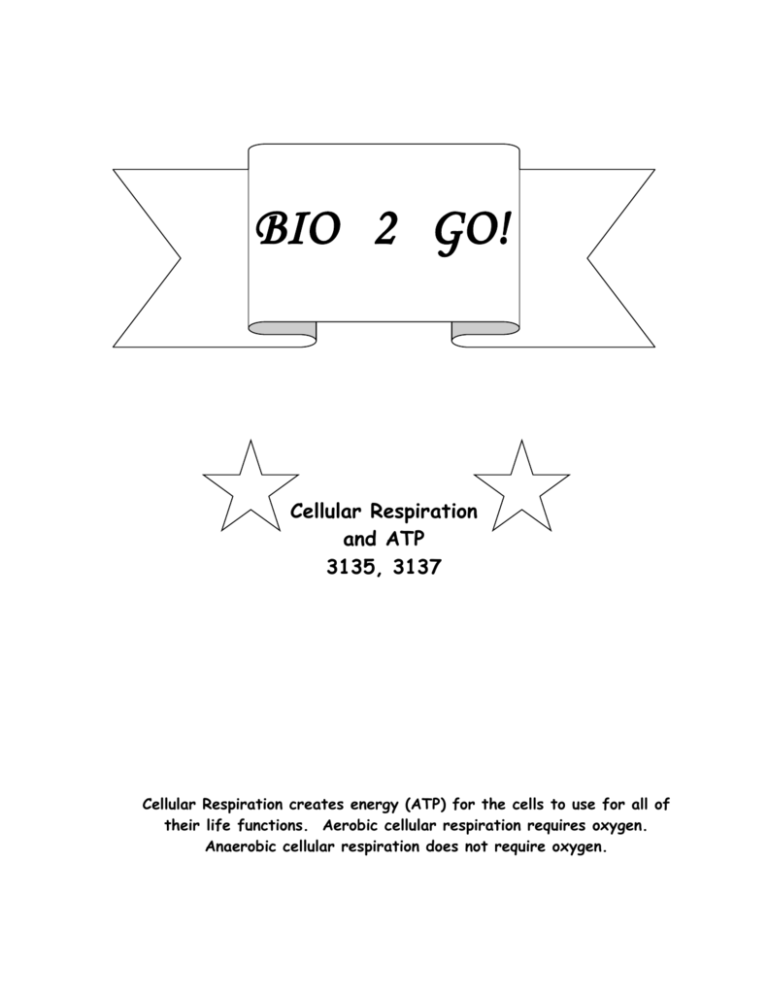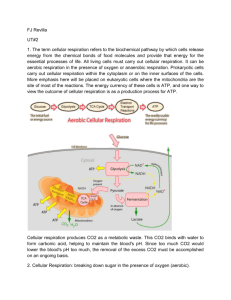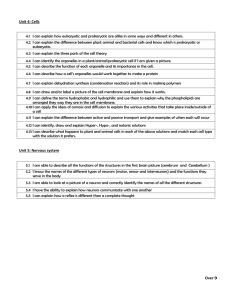wastes respiration
advertisement

BIO 2 GO! Cellular Respiration and ATP 3135, 3137 Cellular Respiration creates energy (ATP) for the cells to use for all of their life functions. Aerobic cellular respiration requires oxygen. Anaerobic cellular respiration does not require oxygen. Cellular Respiration and ATP 3135, 3137 As a result of this unit, you should be able to do the following: 1. Explain the function of cellular respiration 2. Compare and contrast the 2 types of cellular respiration. 3. Write the equation for aerobic cellular respiration. 4. Explain in detail, the process of aerobic cellular respiration. 5. Describe ATP 6. Explain how ATP is used by the cells. 7. Use the following words in their correct context. a. b. c. d. e. f. g. cellular respiration aerobic cellular respiration anaerobic cellular respiration ATP glucose carbon dioxide oxygen Cellular Respiration and ATP 3135, 3137 Cellular respiration creates energy in the form of ATP for the cell too use for all life functions. There are 2 types of cellular respiration: 1) aerobic and 2) anaerobic. In both cases, the function of respiration is to create energy that is useful to the cells. 1) Aerobic Cellular Respiration: Respiration that uses oxygen is called aerobic respiration. Aerobic creates a lot of useful energy. It creates more energy than anaerobic. It is the most common and familiar to humans. 2) Anaerobic Respiration: Respiration that does not require oxygen is called anaerobic respiration. Anaerobic does not create much energy. It creates less energy than aerobic. REMEMBER THS !!! Aerobic cellular respiration requires oxygen and releases a lot of energy. Anaerobic cellular respiration does not require oxygen and releases small amounts of energy. Aerobic creates more energy than anaerobic. They both produce energy that is useful to the cells. Question 1. Explain the function for cellular respiration. Breaks down food for use by animals (and plants) in cellular functions. Question 2. Distinguish between aerobic cellular respiration and anaerobic cellular respiration. Aerobic respiration uses oxygen and releases a lot of energy, anaerobic respiration does not use oxygen and produces less energy. Aerobic Cellular Respiration During aerobic cellular respiration glucose (food) combines with oxygen to create energy, carbon dioxide, and water. The purpose of cellular respiration is to create energy. The energy that is created is useful to the living organism. Cellular respiration takes place in all of the cells of both plants and animals. REMEMBER THIS !!! The equation for aerobic cellular respiration: Glucose + oxygen ENERGY (ATP) + carbon dioxide + water Or C6H12O6 + 6O2 → Energy + 6CO2 + 6H2O Interesting Scientific Fact: If you were to reverse the equation for aerobic cellular respiration, it would be the equation for photosynthesis. The waste products of respiration are the starting chemicals for photosynthesis. The waste products for photosynthesis are the starting chemicals for respiration. They are a cycle. ATP The energy that is created during cellular respiration is stored as ATP. ATP is a molecule that stores and releases energy whenever a cell needs it. The energy released from ATP allows the cells to function properly. Most of the energy that is released from ATP is in the form of heat. Interesting Scientific Fact: The heat given off by the release of energy from ATP is what creates your body temperature. That is why when you are exercising, you are warmer than when you are resting. When you are exercising, more cells are using aerobic cellular respiration to make energy. Therefore, when you are exercising, more ATP molecules are being converted into energy which then creates more body heat. REMEMBER THIS !!! ATP is the energy molecule. It can store and release energy as the cell requires it. Question 3. Without looking, write the equation that describes aerobic cellular respiration. Glucose + oxygen makes ENERGY (ATP) + carbon dioxide + water Question 4. What is ATP? How is it used in aerobic cellular respiration? ATP is the energy molecule produced by cellular respiration. It stores and releases energy for the cell to use as it needs it. How Aerobic Cellular Respiration works: Glucose is a carbohydrate. Remember! Carbohydrates are the energy containing organic molecules. Glucose is created through the digestion of carbohydrates in food. Oxygen is one of the gases in the air. When you breathe, you bring oxygen into your body. The oxygen is then moved to your cells. The glucose from the food you eat, and the oxygen from the air you breathe is both present in every cell. During the process of aerobic cellular respiration they are combined to release energy in the form of ATP, along with the waste products carbon dioxide, and water. Question 5. On the back of this page, explain aerobic cellular respiration and ATP. Student answers may vary, but should be based on the paragraph above. Interesting Scientific Fact: The mitochondrion is the cell part that performs aerobic cellular respiration. In certain muscle cells that are very active and require a lot of energy, there may be hundreds of mitochondria. (You will need to remember mitochondria and their function for a later unit.) Summary Cellular Respiration and ATP 3135, 3137 Cellular respiration is the process of breaking apart glucose molecules to get energy. There are two types of cellular respiration: 1. Aerobic Respiration – Using oxygen to break down glucose to release large amounts of energy. 2. Anaerobic Respiration - Breaking down glucose to release smaller amounts of energy with no oxygen present. In both processes, the energy given off is stored in a smaller molecule called ATP. ATP is an abbreviation for a long chemical name. Whenever a cell needs energy, it uses ATP molecules. If a cell runs out of ATP, it cannot carry out its reactions and will die. One difference between aerobic and anaerobic respiration is that many, many more ATP can be created during aerobic respiration than during anaerobic. So whenever a cell is using energy, it is using energy stored in its ATP molecules. Each cell needs to create its ATP, so it must perform cellular respiration. The general equation for aerobic respiration: Glucose and oxygen combine to create ATP(energy) and the waste products carbon dioxide and water. C6H12O6 + 6O2 → Energy + 6CO2 + 6H2O Test Yourself Matching __D__ 1. cellular respiration a. a waste product of cellular respiration __E__ 2. aerobic respiration b. a large molecule full of stored energy __F__ 3. anaerobic respiration c. a small molecule used by the cell for energy __C__ 4. ATP d. the process of breaking glucose apart to get energy __B__ 5. glucose e. breaking down glucose with oxygen present __A__ 6. carbon dioxide f. breaking down glucose with no oxygen True or False __F___ 1. During cellular respiration, ATP is broken down. __T___ 2. During cellular respiration, glucose is broken down. __T___ 3. During aerobic respiration, oxygen is present. __F___ 4. During aerobic respiration, oxygen is not present. __T___ 5. During aerobic respiration, ATP are created __F___ 6. During aerobic respiration, ATP are destroyed. __F___ 7. During anaerobic respiration, oxygen is present. __T___ 8. During anaerobic respiration, oxygen is not present. __F___ 9. During anaerobic respiration, a lot of energy is created __T___ 10. During aerobic respiration, a lot of energy is created __T___11. If a cell doesn’t carry out cellular respiration, it cannot create its ATP. __T___ 12. If a cell doesn’t have any ATP, it will die. __T___ 13. The general equation for aerobic respiration is shows energy as a product __F___ 14. The waste products of cellular respiration are glucose and oxygen. __T___ 15. The waste products of cellular respiration are carbon dioxide and water. Fill in the Blank cellular respiration glucose carbon dioxide aerobic ATP water anaerobic oxygen created 1. All cells need _ATP____ molecules to carry out their functions that require energy. 2. The ATP molecules in a cell must be _Created___by cellular respiration. 3. _Cellular Respiration______ is the process that provides the energy to create ATP molecules. 4. During _Aerobic____ respiration, oxygen is present and many ATP molecules can be created. 5. During _Anaerobic___ respiration, oxygen is not present and only a few ATP can be created. 6. The energy to create these ATP molecules comes from the molecule _Glucose____ which is in the food we eat. 7. The waste products of aerobic respiration are _Carbon dioxide__ and _Water_____. 8. An organism that doesn’t have food or __Water_________, is likely to die because it cannot create its ATP. Answer the Following 1. What is the purpose for cellular respiration? To break down glucose so that energy is provided to organisms. 2. What are the two types of cellular respiration? Aerobic and anaerobic 3. Which type of cellular respiration creates the most ATP? Aerobic 4. How would you describe ATP? Energy molecule that is made as a result of cellular respiration. 5. Explain the function of ATP. Provides energy for cells to use when they need it. 6. What is the general equation for aerobic cellular respiration? Glucose + oxygen makes ENERGY (ATP) + carbon dioxide + water Bonus Question 1: What is the name of the cell part that performs aerobic cellular respiration? Mitochondrion Bonus Question 2: Explain how aerobic cellular respiration and photosynthesis are related. The products of one are the reactants of the other. They need each other to survive and carry out their functions.








